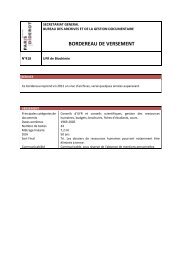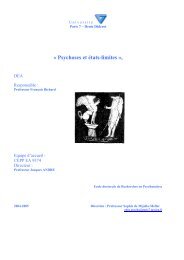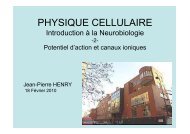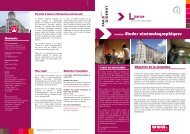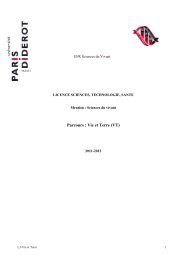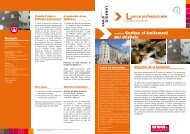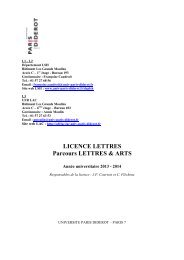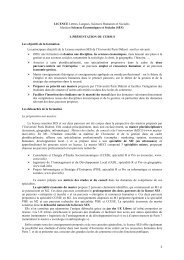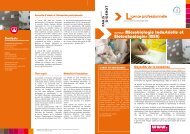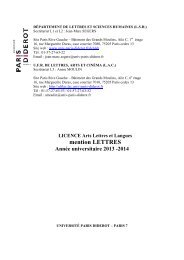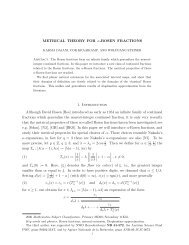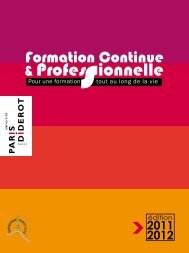Coordinator's names Carole DELPORTE-GALLET Hugues ...
Coordinator's names Carole DELPORTE-GALLET Hugues ...
Coordinator's names Carole DELPORTE-GALLET Hugues ...
You also want an ePaper? Increase the reach of your titles
YUMPU automatically turns print PDFs into web optimized ePapers that Google loves.
Objectives of the task:<br />
Sub-Task 4.1: Characterizing the complexity classes listed above, or at least some fragments of them. For<br />
instance, it can be shown that by slightly reducing the definition, the languages in the class WFD<br />
are in one-to-one correspondence with covering spaces, in the sense of algebraic topology. In general,<br />
one objective of this sub-task is to determine whether these classes are decidable. Defining pertinent<br />
complexity measures for the wait-free model as well as for the mobile agent model is another objective.<br />
Notions like number of memory accesses, number of interactions or number of moves appear to be<br />
natural for the wait-free, population protocol and mobile agent model, respectively.<br />
Sub-Task 4.2: Studying the impact of randomization on the deterministic complexity classes LD, LDC,<br />
WFD, and MAD. For instance, it has been recently shown [19] that LD and BPLD coincide for a<br />
large range of values p and q, if one restricts the languages to the hereditary ones. The question<br />
”does randomization help?” is at the core of computer science. Proving or disproving LD = BPLD is<br />
probably beyond the objectives of this project. Nevertheless, we will work having this type of question<br />
in mind.<br />
Sub-Task 4.3: Defining appropriate notion of reductions that enable to compare the ”difficulty” of problems<br />
belonging to the same class. In the LOCAL model, a straightforward notion of reduction is to<br />
consider local computation mapping one instance to another while preserving the respective language<br />
membership. Defining the analog in, e.g., the framework of wait-free computation appears to be more<br />
challenging, because the notion of termination is more difficult to handle, and because faults can occur<br />
during the reduction.<br />
3.2.5 Task 5: Non-determinism in distributed computing<br />
Coordinator: Amos Korman (Paris)<br />
One can consider LD as the analogue of the class P, and then define the class NLD as the analogue of<br />
the class NP. Specifically, NLD (for non-deterministic local decision) is the class of distributed languages<br />
for which there exists a certificate (or proof ) that can be verified in a constant number of communication<br />
rounds in the LOCAL model. More precisely, NLD is the class of distributed languages L for which there<br />
exists a local algorithm such that:<br />
• if L ∈ L, then there exists a certificate c such that algorithm A applied on L with certificate c outputs<br />
“yes” for all nodes,<br />
• otherwise, for every certificate c, algorithm A applied on L with certificate c outputs “no” for at least<br />
one node.<br />
It is worth noticing that non-deterministic distributed computing does not find its interests in complexity<br />
theory only. In particular, the above notion of non-determinism is very much related to the area of computation<br />
with advice (e.g., [17, 18]), which aims at investigating the amount of information known to each<br />
node and its impact on the performances of the algorithm. In fact, the definition of NLD finds most of<br />
its similarities with the notion of proof labeling schemes (cf., e.g.,[23, 24]) which finds applications in the<br />
context of fault-tolerance and self-stabilization. Roughly, in certain contexts, one can afford spending lot of<br />
time computing the certificate, but once it is given to the nodes, one wants the verification to be fast. (One<br />
example is fault-detection in environments such as a plane or a nuclear plant). Clearly, LD ⊆ NLD, and it<br />
can be shown that LD ≠ NLD. Interestingly enough, it can be also shown that there exists a problem which<br />
is NLD-complete for the local reduction mentioned in Task 4. Still, the nature of NLD is far from being<br />
well-understood.<br />
Similarly, one can define non-deterministic versions of the classes LDC, WFD, and MAD. In the case of<br />
the mobile agent model, restricted to a single agent, it is form instance known that NMAD ∪ co-NMAD =<br />
MAD. As we will see, non-determinism finds all its interests when combined to the notion of oracles, which<br />
will be the objective of Task 3. Task 4 focuses on non-determinism per se.<br />
12



